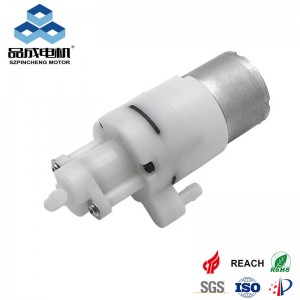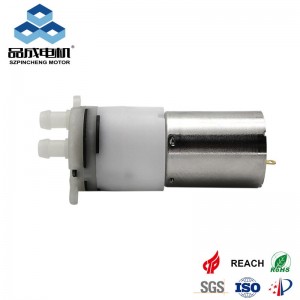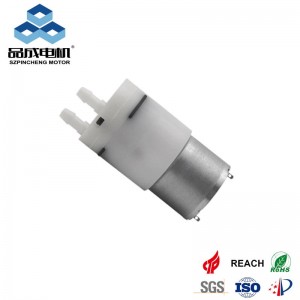Micro Water Pump Selection Method | PINCHENG
There’s many types of Micro water pump in the market, Micro liquid pumps, small gel pump, etc. Then how can we know which one is suitable for the application? There’s some data like “water flow” “pressure” of micro water pump, we can use this micro water pump selection method:
A. Normal temperature working medium (0-50℃), just pumping water or liquid, no need working for both water and air, but requires self-priming ability, and has requirements for flow and output pressure.
Note: The pumped working medium is water, non-oily, non-corrosive liquid and other solutions (cannot contain solid particles, etc.), and must have a self-priming function, you can choose the following pumps
⒈ Large flow requirements (about 4-20 liters/minute), low-pressure requirements (about 1-3 kg), mainly used for water circulation, water sampling, lifting, etc., requiring low noise, long life, high self-priming, etc., You can choose BSP, CSP, etc. series;
2. The flow requirement is not high (about 1 to 5 liters/min), but the pressure is higher (about 2 to 11 kilograms). If it is used for spraying, boosting, car washing, etc., it does not need to work for a long time under high pressure or heavy load. Choose ASP, HSP, etc. series;
3. Used for tea table pumping, spraying, etc., the volume is as small as possible, the flow rate is small, and the noise is small (about 0.1 ~ 3 liters/min), and ASP series are optional
B. Normal temperature working medium (0-50℃) requires pumping water or gas (maybe water-gas mixture or idling, dry running occasions), and value volume, noise, continuous use and other properties.
Note: It requires water and air dual purpose, can run dry for a long time, without damaging the pump; 24 hours of continuous operation; very small size, low noise, but not high requirements for flow and pressure.
1. Use a micro pump to pump air or vacuum, but sometimes liquid water enters the pump cavity.
2. Miniature water pumps are required to pump both air and water
⒊ Use a micro-pump to pump water, but sometimes the pump may have no water to pump and it is in a "dry running" state. Some traditional water pumps can not "dry running", which may even damage the pump. And PHW, WKA series products are essentially a kind of compound function pump
⒋ Mainly use micro pumps to pump water but do not want to manually add "diversion" before pumping (some pumps need to manually add some "diversion" before working so that the pump can pump up the low water, otherwise the pump will not be able to pump water or even be damaged), That is, hope that the pump has a "self-priming" function. At this time, you can choose PHW and WKA series products. Their strengths are: when they are not in contact with water, they will be vacuumed. After the vacuum is formed, the water will be pressed up by air pressure, and then the water will be pumped.
C.High temperature working medium (0-100℃), such as using micro water pump for water circulation heat dissipation, water cooling, or pumping high temperature, high-temperature water vapor, high-temperature liquid, etc., you must use a micro water pump (high-temperature type):
⒈The temperature is between 50-80℃, you can choose the miniature water and gas dual-purpose pump PHW600B (high-temperature medium type) or WKA series high-temperature medium type, the highest temperature is 80℃ or 100℃;
2. If the temperature is between 50-100℃, the WKA series high-temperature medium type must be selected, and the highest temperature resistance is 100℃; (when high-temperature water (water temperature exceeds about 80℃) is extracted, gas will be released in the water. The pumping flow rate is greatly reduced. For the specific flow rate, please refer to here: (This is not a quality problem of the pump, please pay attention when selection!)
D.There is a large requirement for the flow rate (more than 20 liters/min), but the medium contains a small amount of oil, solid particles, residues, etc.
Note: In the medium to be pumped,
⒈ Contain a small number of soft solid particles with a small diameter (such as fish feces, sewage sludge, residue, etc.), but the viscosity should not be too large, and it is best not to have entanglements such as hair;
⒉The working medium is allowed to contain a small amount of oil (such as a small amount of oil floating on the sewage surface), but not all of it is oil!
⒊Large flow requirements (more than 20 liters/min):
⑴ When the self-priming function is not needed, and the pump cannot be put into water, the solid particles can be cut into smaller particles: you can choose the FSP super large flow series.
⑵ When self-priming is required and the pump can be placed in the water, the micro submersible pump QZ (medium flow rate 35-45 liters/minute), QD (large flow rate 85-95 liters/minute), QC (super large flow rate 135-145 liters/minute) can be selected Minutes) Three series of miniature submersible pumps and DC submersible pumps.
Computing costs
For the first purchase, shop around, accurately calculate the price of the pump, and then choose the product that can meet the price you require. But for the user, the role of the magnetic pump in the use process is much higher than the cost of purchasing it. In this way, the wasted working time and maintenance costs when the pump has problems and failures must also be calculated into the overall cost. In the same way, the pump will consume a lot of electric energy during its operation. Over the years, the electric energy consumed by a small pump is staggering.
The follow-up investigation of the sold products by some foreign pump factories shows that the largest amount of money spent by the pump in its service life is not the initial purchase cost, nor the maintenance cost, but the electric energy consumed. I was surprised to find that the value of electric energy consumed by the original pump has far exceeded its own purchase cost and maintenance cost. Considering its own use efficiency, noise, manual maintenance and other reasons, what reason do we have to buy those inferior prices? What about low "parallel imports" products?
In fact, the principle of a certain type of pump is the same, and the structure and components inside are similar. The biggest difference is reflected in the selection of materials, workmanship and quality of the components. Unlike other products, the difference in the cost of pump components is very significant, and the gap is so large that most people can't imagine it. For example, a very small shaft seal can be bought for a few cents cheaper, while a good product costs tens or even hundreds of yuan. It is conceivable that the difference between the products manufactured by these two products is huge, and The worry is that they are almost indistinguishable in the initial use process. The price gap of hundreds or thousands of times is reflected in the performance and service life of the product. Short-lived (a few months), noise (appears after one or two months), liquid leakage (appears after two or three months) and other phenomena have occurred one after another, which makes many users regret that they should not start to save the price difference. The loud noise and high heat during use are actually precious electrical energy converted into useless kinetic energy (mechanical friction) and thermal energy, but the actual effective work (pumping) is pitifully small.
Learn more about PINCHENG products
Post time: Sep-26-2021




